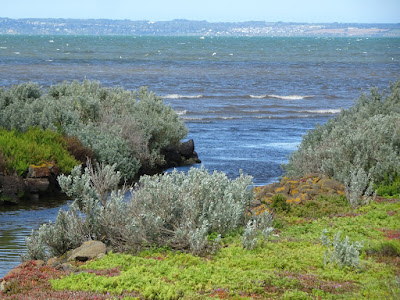This is what the second day of this very busy weekend was all about:
Looking through binoculars!
We were at the Western Treatment Plant, a quite amazing place for watching birds. Many, many birds! How many species of bird do you think are in this photo?
This is why the binoculars were required. The swans are obvious. But the two large white birds are two different species of spoonbill. There is a duck at the back that you can only see the head of. There are masked lapwings in front of the swans, a couple of species of stilts, and some small brown birds amongst the grass that are really hard to see. Without binoculars you would see this sort of view:
All those little black spots on the second pond over are birds. The You Yangs in the background, with Avalon airport between them and the treatment plant.
Pelicans fly over gracefully:
How many species here?
No idea! There are swans, gulls, ducks, cormorants, and I don't know what else. This is looking over to Port Phillip Bay, near one of the outlets. The outlet water is relatively rich in nutrients, so sustains an enormous amount of life. This density of waterbirds is not a normal coastal scene.
Pelicans, cormorants swans, gulls:
So many birds! It was such a privilege to join this excursion. You need a permit to access the site, so this was a rare opportunity to visit in the company of people with permits.
If you click on these information signs they might expand enough to read them:
We did see a lot of swans. This sign says that up to 1,000 swans breed here. Once you add in all their offspring, there are many many swans at this time of year.
This sign says that 280 species of birds use the treatment plant. Some are permanent residents, and some are migratory birds only here for part of the year.
The expert bird-spotters in our group counted 60 different species today. The most exciting was spotted just near here:
One of the outlets to the bay. Just after I took this photo, someone spotted a green parrot on the rocks a little bit to the left. It hopped around a bit, and had a bath, while people with good cameras took many photos of it. I didn't because I didn't think I could zoom in enough to get a good shot. But I really regretted that later, when I discovered that it wasn't just any green parrot, it was actually Australia's rarest bird.
A critically endangered orange-bellied parrot!
Added later: See some photos of the "OBP", taken by another member of the group, at iNaturalist here.
Sunday, March 8, 2020
Subscribe to:
Post Comments (Atom)










5 comments:
Wow--what a slew of birds--just must have been an amazing sight...;)))
we are pretty much home based now that everything is closed here--schools just announced a 2 week closure and then they will re-evaluate...stay safe hugs, Julierose
A really special day, and you know you saw the rare parrot - no photo necessary to prove it.
Love seeing pelicans flying, they look so sleek and powerful, very different from when they are on the ground.
Finally, your picture just above the signs is terrific. Really teeming with life.
Here's a closer look at your orange bellied parrot
https://www.inaturalist.org/observations/39693535
A wonderful day for you to experience. While working at the rose garden we saw many types of birds flying over towards the treatment plant. In the early mornings, the pelicans would gracefully glide above us. Who would have thought all those years ago, something not so pleasant as a MMBW treatment plant would become something so beautiful with the birds.
I’m fascinated by all the birds. How exciting for you!
Post a Comment